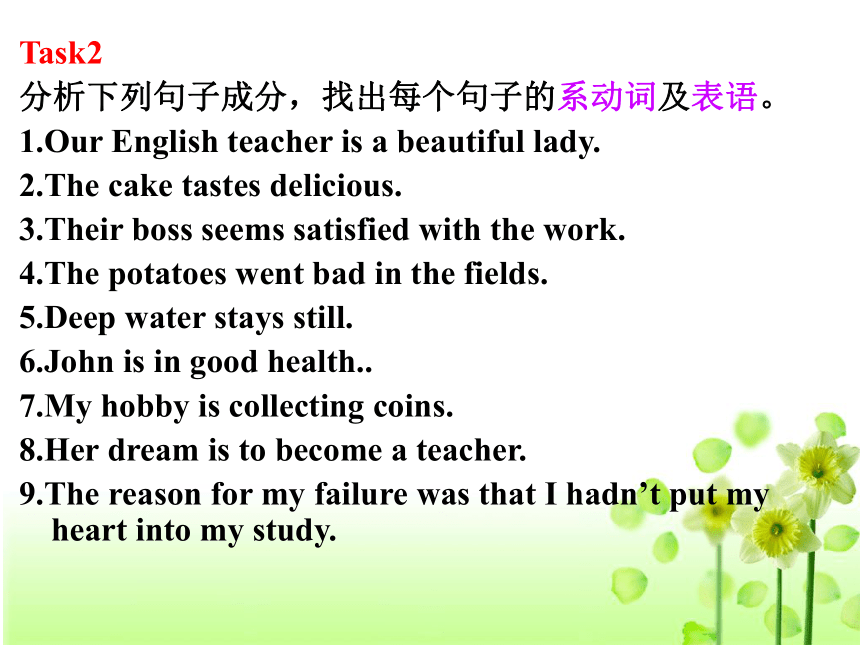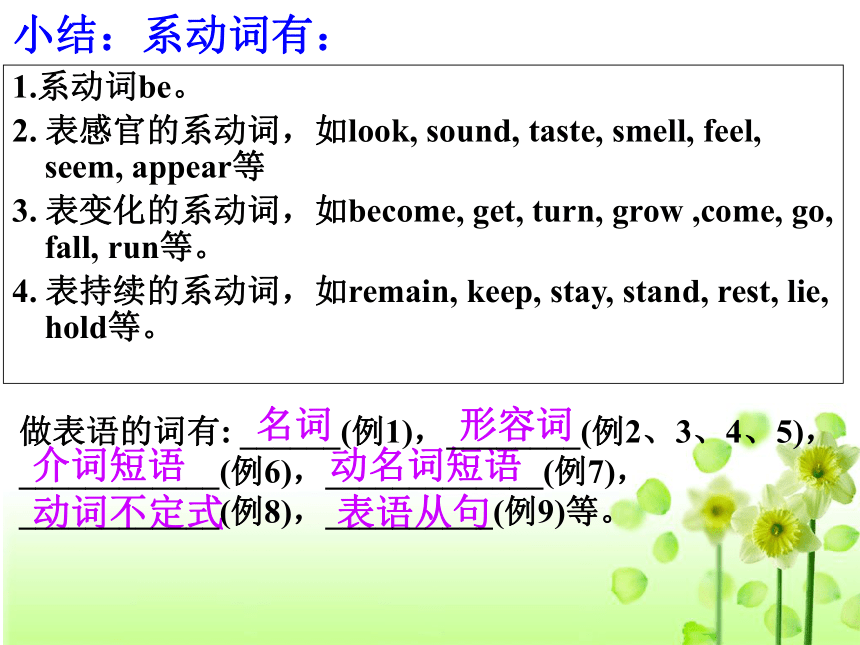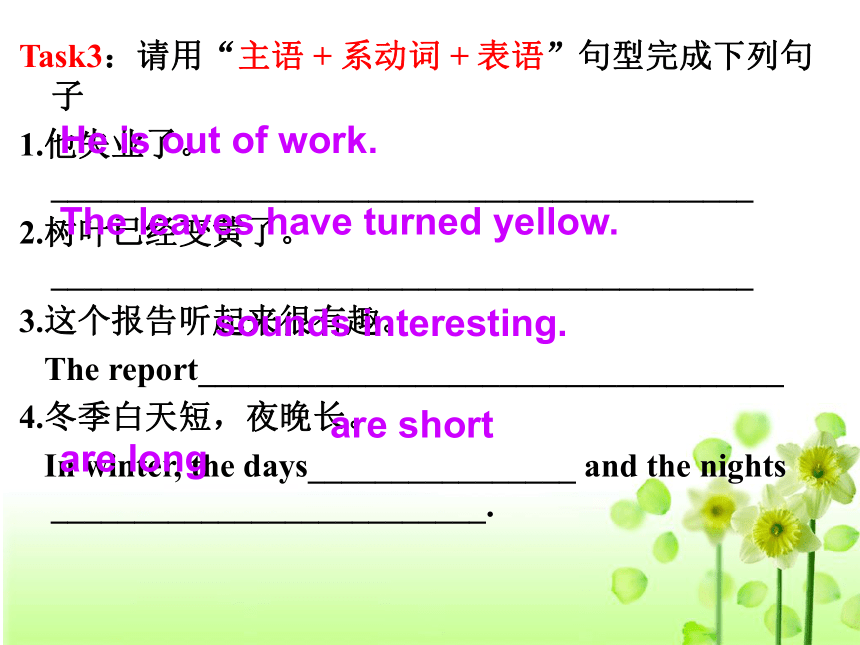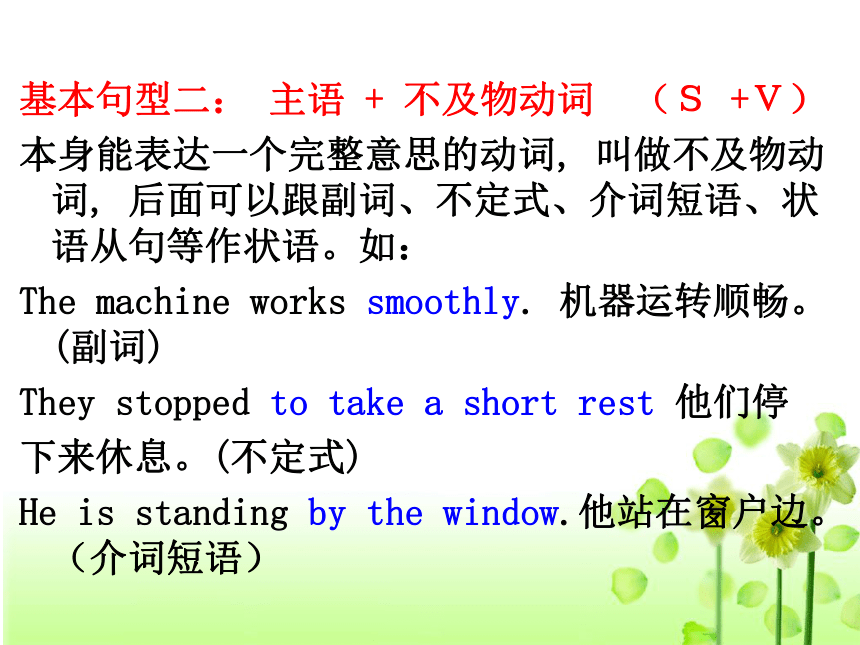初中英语五个简单基本句型(共25张PPT)
文档属性
| 名称 | 初中英语五个简单基本句型(共25张PPT) |  | |
| 格式 | zip | ||
| 文件大小 | 301.5KB | ||
| 资源类型 | 教案 | ||
| 版本资源 | 通用版 | ||
| 科目 | 英语 | ||
| 更新时间 | 2019-11-15 12:58:09 | ||
图片预览









文档简介
(共26张PPT)
英语五个基本句型
学习目标:
1、学会分析句子成分及五个基本句型结构
2、能运用五个基本句型结构翻译句子
Ⅰ. 自主学习
Task1 句子成分分析:请找出下列句子的主语、谓语、宾语、定语、状语、补语、或表语。
1.She is happy.
2.She came.
3.She likes English.
4.She gave John a book.
5.She bought a book for me.
6.She makes her mother angry.
7.The teacher asked me to read the passage.
小结:句子的组成部分分为:_____、______、_____、________、_______、_______、_______,其中______与_______是主要成分,一般不可缺少。
主语
谓语
宾语
定语
状语
补语
表语
主语
谓语
Ⅱ. 探究合作
基本句型一:主语+系动词+表语 (S +V +P)
本结构主要用以说明主语的特征,类属,状态,身份等。该句型中, 谓语动词不能表达一个完整的意思, 必须加上一个表明主语身份或状态的表语构成复合谓语, 才能表达完整的意思。这类动词叫做系动词。
Task2
分析下列句子成分,找出每个句子的系动词及表语。
1.Our English teacher is a beautiful lady.
2.The cake tastes delicious.
3.Their boss seems satisfied with the work.
4.The potatoes went bad in the fields.
5.Deep water stays still.
6.John is in good health..
7.My hobby is collecting coins.
8.Her dream is to become a teacher.
9.The reason for my failure was that I hadn’t put my heart into my study.
小结:系动词有:
1.系动词be。
2. 表感官的系动词,如look, sound, taste, smell, feel, seem, appear等
3. 表变化的系动词,如become, get, turn, grow ,come, go, fall, run等。
4. 表持续的系动词,如remain, keep, stay, stand, rest, lie, hold等。
名词
形容词
介词短语
动名词短语
动词不定式
表语从句
做表语的词有: ______(例1),________(例2、3、4、5),____________(例6),_____________(例7),
____________(例8),__________(例9)等。
Task3:请用“主语 + 系动词 + 表语”句型完成下列句子
1.他失业了。 __________________________________________
2.树叶已经变黄了。 __________________________________________
3.这个报告听起来很有趣。
The report___________________________________
4.冬季白天短,夜晚长。
In winter, the days________________ and the nights __________________________.
He is out of work.
The leaves have turned yellow.
sounds interesting.
are short
are long
5.十五岁他就成为有名的歌手了。
At the age of fifteen, ___________________________________________
6.孩子们很少保持安静。
Children seldom______________________
7.她的工作是在幼儿园里照看儿童。
_______________________________________in the nursery.
he became a famous singer.
keep quiet.
Her job is to look after the chilren
基本句型二: 主语 + 不及物动词 (S +V)
本身能表达一个完整意思的动词, 叫做不及物动词, 后面可以跟副词、不定式、介词短语、状语从句等作状语。如:
The machine works smoothly. 机器运转顺畅。(副词)
They stopped to take a short rest 他们停
下来休息。(不定式)
He is standing by the window.他站在窗户边。(介词短语)
Task4:请用“主语 + 不及物动词”句型完成下列句子。
1.我们正在排队等候。
_________________________________
2.我们勤奋学习。
__________________________________
3.他每年旅游好几个月。
__________________________________________________
4.他昨晚很晚回家。
___________________________________________________
5.在过去的十年里,我的家乡发生了巨大的变化。(take place, great changes)
_________________________________________________________in the past ten years.
We are waiting in line.
We study hard.
He travels for several months every year.
He went home very late last night/ yesterday evening.
Great changes have taken place in my hometown
基本句型三: 主语 + 及物动词 + 宾语 (S +V +O)
及物动词本身需要一个动作的接受者(宾语), 才可以表达
一个完整的意思。做宾语的可以是名词、代词、不定式
等。如:
Mary enjoys music. 玛丽喜欢音乐。(名词)
He loves her. 他爱她。(代词)
I want to get your help.我想得到您的帮助。(不定式短语)
I don’t know what to do.我不知道该怎么办。(疑问词+
不定式)
The old man enjoys living in the countryside. 那老人喜欢
住在乡村。(动名词短语)
I don’t think he’s right. 我认为他不对。(宾语从句)
Task5:请用“主语 + 及物动词 + 宾语”句型完成下列句子。
1.我们在368名学生中进行了一次调查。
___________________________ among 368 students.
2.我承诺以后要把主要精力放在学习上。
I_______________________mainly on my study.
3.这比赛目的在于提高学生的环保意识。(aim to do sth)
The contest ________________________ students’ awareness of protecting the environment.
4.我们已决定什么时候出发。(set off)
___________________________________________________
5.我不知道该怎么办。
__________________________________________________
We did a survey
promise to focus
aims to improve
We have decided when to set off.
I don't know what to do.
基本句型四: 主语+及物动词+间接宾语+直接宾语
(S +V +IO +DO)
该句型中的谓语动词必须跟有两个宾语才能表达完整的意思。一个是表示人的间接宾语;一个是表示物的直接宾语。间接宾语一般在前面, 直接宾语在后面。如:
Tom left Mary a message.汤姆给玛丽留下了口信。
This will save you much time.这将为您节约大量的时间。
有时直接宾语和间接宾语可以对调, 这时, 间接宾语前应
加上介词to, for或of。
1.主+及物动词+物(直宾)+to+人(间宾)。如:
He offered a job to her.他向她提供了一份工作。
I owe my success to you.我的成功要归功于您。
归纳:间接宾语前要用to的常用动词有:give, tell, lend, sell, teach, send, write, show, return, bring, pass, leave, offer, hand等。
2.主+及物动词+ 物(直宾)+for+人(间宾)。如:
He ordered some food for the two of them. 他为他们俩点了一些食物。
Mother made a nice dress for the little girl. 妈妈给小女孩做了条美丽的裙子。
归纳:间接宾语前加介词for的动词有:buy, choose, get, make, order, sing, do, play,save等。
3.主+及物动词+人(间宾)+of+物(直宾)。如:
They robbed the old man of his money. 他们抢了老人的钱。
He’s warned me of the danger.他警告我注意危险。
归纳:直接宾语前加介词of的动词有:cure, convince (使信服), inform, rob, rid(摆脱, 赶走, 清除), warn。
Task6:请用“主语+及物动词+间接宾语+直接宾语 ”句型完成下列句子。
1.我想为父亲挑选一份合适的礼物。
I want to ________ a suitable ___________ _________ my father.
2.母爱给我们力量。
Mother’s love _____ ____ __________.
3.请在本周末把所借的书都还给图书。
Please ____________________________________by this weekend.
4.Tom使Mary相信了他的诚实。
Tom __________ ________ ___ his honesty.
5.奶奶昨晚给我们讲了一个有趣的故事。
Grandma told ____ _____________________ last night.
choose
gift/ present
for
gives
return all the books to the library
us
power/ gives power to us
convinced
Mary
of
us
an interesting story
基本句型五: 主语+及物动词+宾语+宾补 (S+V+O+OC)
此结构由“主语+及物动词+宾语+宾语补足语”构成。宾语与宾语补足语之间有逻辑上的主谓关系或主表关系,若无宾语补足语,则句意不够完整。可以用做宾补的有:名词,形容词,副词(仅限少数几个),介词短语,动词不定式,分词等。如:
1.The news made me happy.
2.They made Tom their monitor.
3.I found myself in dark. (我发现自己还蒙在鼓里。)
4.He encouraged her to work harder.
5.I heard him singing.
6.You must get your hair cut.
7.He used to do his homework with his radio on.
用 it 做形式宾语,而将真正的宾语放到宾语补足语的后面,以使句子结构平衡,是英语常用的句型结构方式。即:主语+谓语+it+宾补+真正宾语。如:
I found it very pleasant to be with your family.
Task7:请用“主语+及物动词+宾语+宾补 ”句型完成下列句子。
1.我们叫她Alice。___________________________
2.我们大家都认为他是诚实的。_______________________________________________
3.我要你把真相告诉我。(the truth) _______________________________________________
4. 每天早晨我们都听到他大声朗读英语。
We _____________________________ aloud every morning.
5. 他踢足球时摔断了腿。(have sth done)
He ______________________while playing football.
6.他感到很难跟你交谈。______________________________________________.
We all call her Alice.
We all consider him honest.
He felt/ found it hard/ difficult to talk with you
hear him reading English
had his leg broken
I want you to tell me the truth.
III. 练习巩固
Task8 用简单句翻译下列各句,然后通过适当添加细节和关联词将其合并成5句话的连贯短文,这5句话依然是简单句。
1. 这是我的妈妈。
This is my mother. (主+系+表)
2. 她是一个普通的家庭妇女。
She is an ordinary housewife. (主+系+表)
3. 刚才她坐在那儿。
My mother was sitting there. (主+谓)
4. 她在看电视。
4. She was watching TV. (主+谓+宾)
5. 我感到意外。
5. I felt surprised. (主+系+表)
6. 她在哭泣。
6. She was weeping/crying. (主+谓)
7. 什么事才可使她高兴?
What could make her happy? (主+谓+宾+宾补)
8. 我给她讲了一个滑稽可笑的故事。
I told her a very funny story. (主+谓+双宾)
9. 她情不自禁地笑了起来。
She couldn’t help laughing. (主+谓+宾)
This is my mother, an ordinary housewife. Just now, she was sitting there, watching TV. Much to my surprise, I found her weeping. In order to make her happy, I told her a very funny story. Sure enough, she couldn’t help laughing.
合并:
IV. 反思小结:
1.今天学到了什么?
2.归纳错题,总结自己常犯的错误,该如何应对?
3.学到了哪些解题思路及技巧。
Thank you !
英语五个基本句型
学习目标:
1、学会分析句子成分及五个基本句型结构
2、能运用五个基本句型结构翻译句子
Ⅰ. 自主学习
Task1 句子成分分析:请找出下列句子的主语、谓语、宾语、定语、状语、补语、或表语。
1.She is happy.
2.She came.
3.She likes English.
4.She gave John a book.
5.She bought a book for me.
6.She makes her mother angry.
7.The teacher asked me to read the passage.
小结:句子的组成部分分为:_____、______、_____、________、_______、_______、_______,其中______与_______是主要成分,一般不可缺少。
主语
谓语
宾语
定语
状语
补语
表语
主语
谓语
Ⅱ. 探究合作
基本句型一:主语+系动词+表语 (S +V +P)
本结构主要用以说明主语的特征,类属,状态,身份等。该句型中, 谓语动词不能表达一个完整的意思, 必须加上一个表明主语身份或状态的表语构成复合谓语, 才能表达完整的意思。这类动词叫做系动词。
Task2
分析下列句子成分,找出每个句子的系动词及表语。
1.Our English teacher is a beautiful lady.
2.The cake tastes delicious.
3.Their boss seems satisfied with the work.
4.The potatoes went bad in the fields.
5.Deep water stays still.
6.John is in good health..
7.My hobby is collecting coins.
8.Her dream is to become a teacher.
9.The reason for my failure was that I hadn’t put my heart into my study.
小结:系动词有:
1.系动词be。
2. 表感官的系动词,如look, sound, taste, smell, feel, seem, appear等
3. 表变化的系动词,如become, get, turn, grow ,come, go, fall, run等。
4. 表持续的系动词,如remain, keep, stay, stand, rest, lie, hold等。
名词
形容词
介词短语
动名词短语
动词不定式
表语从句
做表语的词有: ______(例1),________(例2、3、4、5),____________(例6),_____________(例7),
____________(例8),__________(例9)等。
Task3:请用“主语 + 系动词 + 表语”句型完成下列句子
1.他失业了。 __________________________________________
2.树叶已经变黄了。 __________________________________________
3.这个报告听起来很有趣。
The report___________________________________
4.冬季白天短,夜晚长。
In winter, the days________________ and the nights __________________________.
He is out of work.
The leaves have turned yellow.
sounds interesting.
are short
are long
5.十五岁他就成为有名的歌手了。
At the age of fifteen, ___________________________________________
6.孩子们很少保持安静。
Children seldom______________________
7.她的工作是在幼儿园里照看儿童。
_______________________________________in the nursery.
he became a famous singer.
keep quiet.
Her job is to look after the chilren
基本句型二: 主语 + 不及物动词 (S +V)
本身能表达一个完整意思的动词, 叫做不及物动词, 后面可以跟副词、不定式、介词短语、状语从句等作状语。如:
The machine works smoothly. 机器运转顺畅。(副词)
They stopped to take a short rest 他们停
下来休息。(不定式)
He is standing by the window.他站在窗户边。(介词短语)
Task4:请用“主语 + 不及物动词”句型完成下列句子。
1.我们正在排队等候。
_________________________________
2.我们勤奋学习。
__________________________________
3.他每年旅游好几个月。
__________________________________________________
4.他昨晚很晚回家。
___________________________________________________
5.在过去的十年里,我的家乡发生了巨大的变化。(take place, great changes)
_________________________________________________________in the past ten years.
We are waiting in line.
We study hard.
He travels for several months every year.
He went home very late last night/ yesterday evening.
Great changes have taken place in my hometown
基本句型三: 主语 + 及物动词 + 宾语 (S +V +O)
及物动词本身需要一个动作的接受者(宾语), 才可以表达
一个完整的意思。做宾语的可以是名词、代词、不定式
等。如:
Mary enjoys music. 玛丽喜欢音乐。(名词)
He loves her. 他爱她。(代词)
I want to get your help.我想得到您的帮助。(不定式短语)
I don’t know what to do.我不知道该怎么办。(疑问词+
不定式)
The old man enjoys living in the countryside. 那老人喜欢
住在乡村。(动名词短语)
I don’t think he’s right. 我认为他不对。(宾语从句)
Task5:请用“主语 + 及物动词 + 宾语”句型完成下列句子。
1.我们在368名学生中进行了一次调查。
___________________________ among 368 students.
2.我承诺以后要把主要精力放在学习上。
I_______________________mainly on my study.
3.这比赛目的在于提高学生的环保意识。(aim to do sth)
The contest ________________________ students’ awareness of protecting the environment.
4.我们已决定什么时候出发。(set off)
___________________________________________________
5.我不知道该怎么办。
__________________________________________________
We did a survey
promise to focus
aims to improve
We have decided when to set off.
I don't know what to do.
基本句型四: 主语+及物动词+间接宾语+直接宾语
(S +V +IO +DO)
该句型中的谓语动词必须跟有两个宾语才能表达完整的意思。一个是表示人的间接宾语;一个是表示物的直接宾语。间接宾语一般在前面, 直接宾语在后面。如:
Tom left Mary a message.汤姆给玛丽留下了口信。
This will save you much time.这将为您节约大量的时间。
有时直接宾语和间接宾语可以对调, 这时, 间接宾语前应
加上介词to, for或of。
1.主+及物动词+物(直宾)+to+人(间宾)。如:
He offered a job to her.他向她提供了一份工作。
I owe my success to you.我的成功要归功于您。
归纳:间接宾语前要用to的常用动词有:give, tell, lend, sell, teach, send, write, show, return, bring, pass, leave, offer, hand等。
2.主+及物动词+ 物(直宾)+for+人(间宾)。如:
He ordered some food for the two of them. 他为他们俩点了一些食物。
Mother made a nice dress for the little girl. 妈妈给小女孩做了条美丽的裙子。
归纳:间接宾语前加介词for的动词有:buy, choose, get, make, order, sing, do, play,save等。
3.主+及物动词+人(间宾)+of+物(直宾)。如:
They robbed the old man of his money. 他们抢了老人的钱。
He’s warned me of the danger.他警告我注意危险。
归纳:直接宾语前加介词of的动词有:cure, convince (使信服), inform, rob, rid(摆脱, 赶走, 清除), warn。
Task6:请用“主语+及物动词+间接宾语+直接宾语 ”句型完成下列句子。
1.我想为父亲挑选一份合适的礼物。
I want to ________ a suitable ___________ _________ my father.
2.母爱给我们力量。
Mother’s love _____ ____ __________.
3.请在本周末把所借的书都还给图书。
Please ____________________________________by this weekend.
4.Tom使Mary相信了他的诚实。
Tom __________ ________ ___ his honesty.
5.奶奶昨晚给我们讲了一个有趣的故事。
Grandma told ____ _____________________ last night.
choose
gift/ present
for
gives
return all the books to the library
us
power/ gives power to us
convinced
Mary
of
us
an interesting story
基本句型五: 主语+及物动词+宾语+宾补 (S+V+O+OC)
此结构由“主语+及物动词+宾语+宾语补足语”构成。宾语与宾语补足语之间有逻辑上的主谓关系或主表关系,若无宾语补足语,则句意不够完整。可以用做宾补的有:名词,形容词,副词(仅限少数几个),介词短语,动词不定式,分词等。如:
1.The news made me happy.
2.They made Tom their monitor.
3.I found myself in dark. (我发现自己还蒙在鼓里。)
4.He encouraged her to work harder.
5.I heard him singing.
6.You must get your hair cut.
7.He used to do his homework with his radio on.
用 it 做形式宾语,而将真正的宾语放到宾语补足语的后面,以使句子结构平衡,是英语常用的句型结构方式。即:主语+谓语+it+宾补+真正宾语。如:
I found it very pleasant to be with your family.
Task7:请用“主语+及物动词+宾语+宾补 ”句型完成下列句子。
1.我们叫她Alice。___________________________
2.我们大家都认为他是诚实的。_______________________________________________
3.我要你把真相告诉我。(the truth) _______________________________________________
4. 每天早晨我们都听到他大声朗读英语。
We _____________________________ aloud every morning.
5. 他踢足球时摔断了腿。(have sth done)
He ______________________while playing football.
6.他感到很难跟你交谈。______________________________________________.
We all call her Alice.
We all consider him honest.
He felt/ found it hard/ difficult to talk with you
hear him reading English
had his leg broken
I want you to tell me the truth.
III. 练习巩固
Task8 用简单句翻译下列各句,然后通过适当添加细节和关联词将其合并成5句话的连贯短文,这5句话依然是简单句。
1. 这是我的妈妈。
This is my mother. (主+系+表)
2. 她是一个普通的家庭妇女。
She is an ordinary housewife. (主+系+表)
3. 刚才她坐在那儿。
My mother was sitting there. (主+谓)
4. 她在看电视。
4. She was watching TV. (主+谓+宾)
5. 我感到意外。
5. I felt surprised. (主+系+表)
6. 她在哭泣。
6. She was weeping/crying. (主+谓)
7. 什么事才可使她高兴?
What could make her happy? (主+谓+宾+宾补)
8. 我给她讲了一个滑稽可笑的故事。
I told her a very funny story. (主+谓+双宾)
9. 她情不自禁地笑了起来。
She couldn’t help laughing. (主+谓+宾)
This is my mother, an ordinary housewife. Just now, she was sitting there, watching TV. Much to my surprise, I found her weeping. In order to make her happy, I told her a very funny story. Sure enough, she couldn’t help laughing.
合并:
IV. 反思小结:
1.今天学到了什么?
2.归纳错题,总结自己常犯的错误,该如何应对?
3.学到了哪些解题思路及技巧。
Thank you !
同课章节目录
- 词法
- 名词
- 动词和动词短语
- 动词语态
- 动词时态
- 助动词和情态动词
- 非谓语动词
- 冠词
- 代词
- 数词和量词
- 形容词副词及其比较等级
- 介词和介词短语
- 连词和感叹词
- 构词法
- 相似、相近词比较
- 句法
- 陈述句
- 一般疑问句和否定疑问句
- 特殊疑问句及选择疑问句
- 反意疑问句
- 存在句(There be句型)
- 宾语从句
- 定语从句
- 状语从句
- 主谓一致问题
- 简单句
- 并列句
- 复合句
- 主谓一致
- 主、表语从句
- 名词性从句
- 直接引语和间接引语
- 虚拟语气
- 感叹句
- 强调句
- 倒装句
- 祈使句
- 句子的成分
- 句子的分类
- 题型专区
- 单项选择部分
- 易错题
- 完形填空
- 阅读理解
- 词汇练习
- 听说训练
- 句型转换
- 补全对话
- 短文改错
- 翻译
- 书面表达
- 任务型阅读
- 语法填空
- 其他资料
